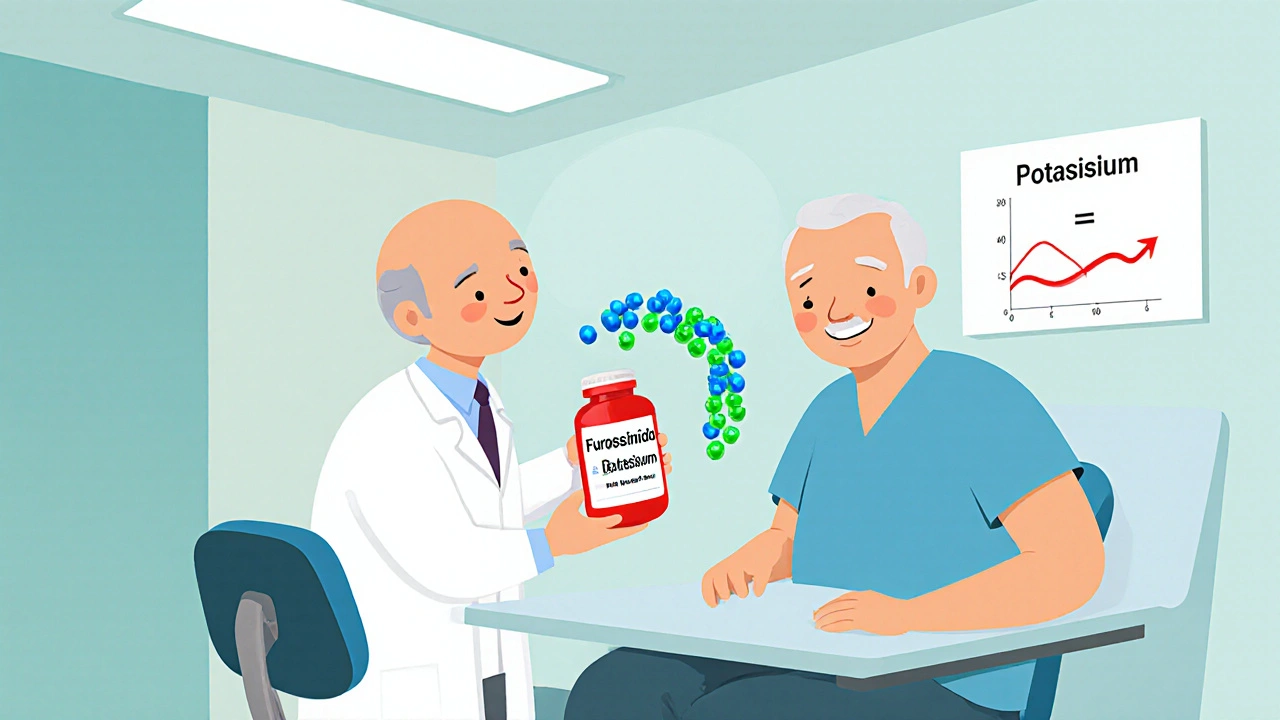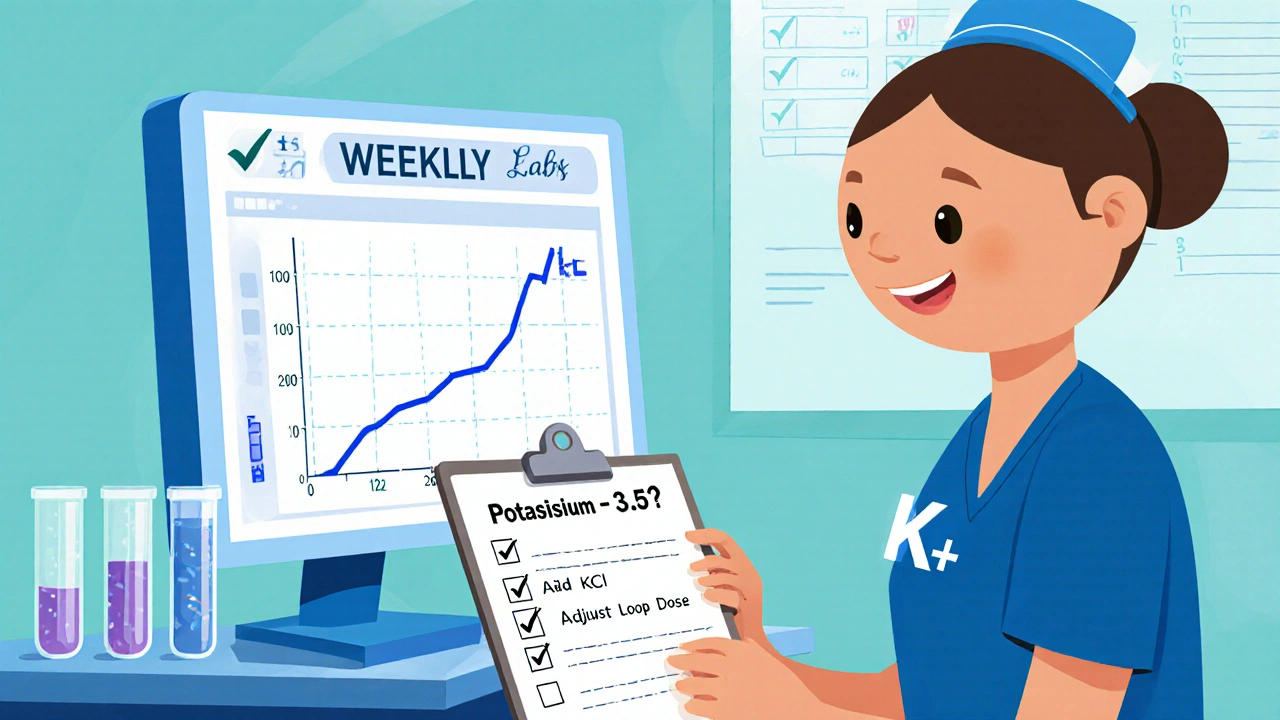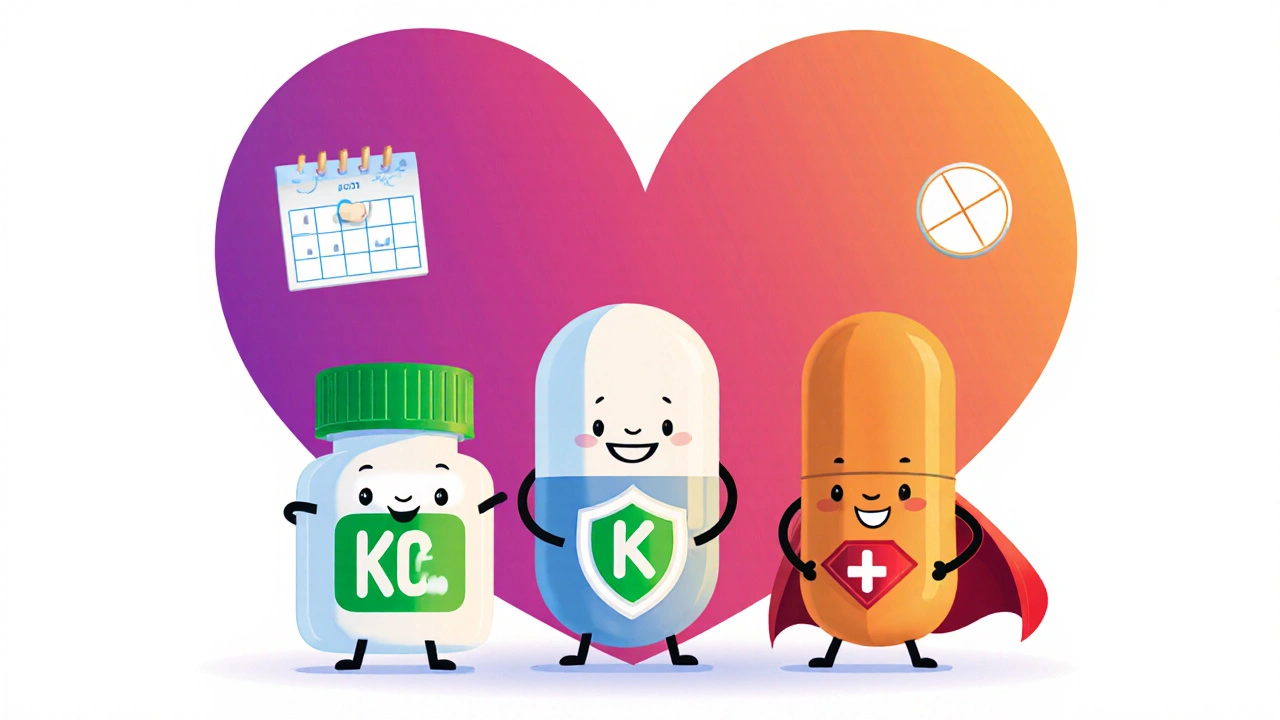Managing Diuretic‑Induced Hypokalemia in Heart Failure Patients: Practical Tips

Potassium Replacement Calculator
Clinical Decision Support
This tool helps calculate potassium replacement needs for heart failure patients on loop diuretics based on serum potassium levels and diuretic dose. Always confirm with clinical guidelines and patient-specific factors.
When you give a heart‑failure patient a diuretics are the go‑to drugs for getting rid of excess fluid, but they can also pull potassium out of the body. That drop in potassium - called Hypokalemiaa serum potassium level below 3.5 mmol/L, which can trigger dangerous heart rhythms - shows up in roughly one‑fourth of patients on loop agents. If you’re a clinician, nurse, or even a patient trying to understand the numbers, you need a clear plan to keep potassium in a safe range while still decongesting the lungs.
Why Loop Diuretics Drop Potassium
Loop Diureticsdrugs that block the Na⁺‑K⁺‑2Cl⁻ cotransporter in the thick ascending limb of the loop of Henle, leading to massive sodium and water excretion (think furosemide, bumetanide, torsemide) flood the distal nephron with sodium. The kidney tries to re‑absorb that sodium by swapping it for potassium through the ROMK channel, so more potassium ends up in the urine.
This mechanism is why a patient on furosemide 40 mg twice daily can see a sudden dip from 4.2 mmol/L to 3.0 mmol/L within a few days, especially if they’re also on a thiazide or have a high‑salt diet.
How Bad Is It? Risk Assessment in Heart Failure
Heart Failurea clinical syndrome where the heart cannot pump enough blood to meet the body’s needs, leading to congestion and reduced exercise tolerance patients already walk a thin line. Studies from the 2020 JACC review show that a serum potassium below 3.5 mmol/L bumps mortality risk by 1.5‑2 times. The 2022 AHA/ACC/HFSA guidelines call hypokalemia a “red flag” because it can spark ventricular tachycardia or even sudden cardiac death.
Key risk factors include:
- High daily loop diuretic dose (>80 mg furosemide equivalents)
- Concurrent use of other potassium‑wasting meds (thiazides, laxatives)
- Underlying Chronic Kidney Diseasereduced glomerular filtration rate that impairs the kidney’s ability to re‑absorb potassium
- Low dietary potassium intake (<2 g/day)
Monitoring: When and How Often
The 2022 guidelines recommend checking potassium and creatinine at least weekly when you start or tweak a diuretic. Once the patient is stable, move to monthly labs, but any dose increase or acute decompensation means you should pull labs every 1‑3 days.
Practical tip: use a simple checklist in the EMR - “potassium < 3.5? consider supplement, adjust dose, add MRA”. That way you catch a dip before the ECG shows a prolonged QT.

Re‑balancing Potassium - What Works
There are three pillars:
- Potassium supplementation - oral potassium chloride 20‑40 mmol/day for mild drops (3.0‑3.5 mmol/L). For severe lows (<3.0 mmol/L), give IV potassium 10‑20 mmol/hour under continuous ECG monitoring.
- Adding a Potassium‑sparing agenta drug that blocks aldosterone or ENaC channels, reducing urinary potassium loss such as spironolactone (12.5‑25 mg daily) or eplerenone (25 mg daily). The RALES trial proved spironolactone cuts mortality by 30 % in HFrEF and also nudges potassium upward.
- Using newer agents that lower diuretic needs - SGLT2 inhibitorsdrugs that block glucose reabsorption in the proximal tubule, producing modest diuresis without heavy potassium loss (empagliflozin 10 mg, dapagliflozin 10 mg). Trials show they can reduce loop dose by 20‑30 % and keep potassium steady.
Dosing Strategies to Smooth Potassium Swings
Instead of a big once‑daily bolus, split the loop dose. Giving furosemide 20 mg every 12 hours yields flatter potassium curves than 40 mg once. If you must stay high‑dose, add a low‑dose thiazide (metolazone 2.5‑5 mg) to achieve the same fluid removal with a lower total loop dose, but monitor potassium closely during the first 48 hours.
For patients with HFpEF, be extra cautious - the DOES trial flagged a higher chance of worsening renal function with aggressive diuresis, which can amplify potassium loss.
Special Populations and Pitfalls
Patients with CKD often have a reduced capacity to re‑absorb potassium, so even modest loop doses can trigger severe hypokalemia. In these cases, start a low‑dose MRA early and keep dietary potassium around 3‑4 g/day.
Don’t forget non‑pharmacologic contributors: laxative overuse, high‑dose insulin for glucose control, or severe vomiting can all deplete potassium.

Emerging Tools and Future Directions
New extended‑release loop formulations aim to provide a steadier diuretic effect, theoretically flattening the sodium‑potassium exchange in the distal tubule. Early data suggest a 15‑20 % drop in hypokalemia episodes compared with standard tablets.
Potassium binders (patiromer, sodium zirconium cyclosilicate) are marketed for hyper‑kalemia, yet small pilot studies hint they might smooth rapid potassium shifts when used prophylactically in high‑risk HF patients. Keep an eye on upcoming trials.
Biomarker‑guided therapy - using BNP or troponin trends to titrate diuretics - has shown a 10‑15 % reduction in electrolyte disturbances, including hypokalemia, because you avoid overshooting diuresis.
Quick Checklist for Clinicians
| Step | Action | Target |
|---|---|---|
| 1 | Baseline labs before starting or changing loop dose | K 3.5‑5.5 mmol/L, Cr < 2 mg/dL |
| 2 | Re‑check labs weekly for first 2 weeks | Detect drop >0.3 mmol/L |
| 3 | Oral KCl 20‑40 mmol/day if K 3.0‑3.5 mmol/L | Raise to ≥3.5 mmol/L |
| 4 | Add spironolactone 12.5‑25 mg daily (or eplerenone 25 mg) | Maintain K 4‑5 mmol/L |
| 5 | Consider SGLT2 inhibitor to lower loop dose | Loop dose ↓20‑30 % |
| 6 | Split loop dose or use ER formulation | Smoother K profile |
Bottom Line
Diuretics are essential for keeping a heart‑failure patient comfortable, but they come with a potassium price tag. By checking labs early, splitting doses, adding a potassium‑sparing agent, and leveraging SGLT2 inhibitors, you can keep potassium in the safe zone and avoid life‑threatening arrhythmias. Stay vigilant, act fast when levels dip, and use the checklist above to make management feel routine rather than a scramble.
How often should potassium be checked after starting a loop diuretic?
The 2022 AHA/ACC/HFSA guideline recommends weekly potassium checks for the first two weeks after initiating or changing a loop diuretic. Once the patient is stable, switch to monthly monitoring, but increase frequency to every 1‑3 days if you raise the dose or the patient is hospitalized.
Can I replace a loop diuretic with an SGLT2 inhibitor to avoid hypokalemia?
SGLT2 inhibitors reduce the need for loop diuretics but don’t replace them completely in most patients with congestion. They are added to the regimen to lower the loop dose by about 20‑30 %, which in turn lessens potassium loss.
What oral potassium dose is safe for a patient on a high‑dose loop?
For mild hypokalemia (3.0‑3.5 mmol/L), 20‑40 mmol of potassium chloride per day is standard. If potassium stays below 3.0 mmol/L, move to IV replacement under ECG monitoring.
Should I give a potassium‑sparing agent to every heart‑failure patient?
Not automatically. Add an MRA (spironolactone or eplerenone) when potassium is at risk of dropping or when you need extra neuro‑hormonal blockade. Monitor potassium and renal function closely, especially in CKD.

10 Comments
These tips read like a hallway brochure and add nothing new.
Well, kudos for highlighting the natriuretic cascade, but let’s be real-most clinicians already know that high‑dose loop diuretics drive renal potassium wasting via the ROMK channel. The article’s “practical tips” are basically an echo of the AHA/ACC guideline bullet points, just dressed up in buzz‑word salad. Still, for trainees who haven’t internalized the relationship between distal sodium delivery and potassium excretion, a quick refresher can be useful. The recommended potassium‑sparing strategies-like adding spironolactone, dietary potassium enhancement, or close electrolyte monitoring-are all textbook, but emphasizing dose titration is essential to avoid the “red flag” hypokalemia. So, keep the jargon flowing; it reminds us that we’re dealing with complex neuro‑hormonal modulation, not just a bag of pills.
Allow me to dissect the exuberant optimism of the previous commentary with the precision of a peer‑reviewed meta‑analysis.
First, the assertion that clinicians are uniformly aware of the ROMK‑mediated potassium loss is, at best, a pedagogical convenience and, at worst, an intellectual oversight.
Empirical data from the 2021 EPIC‑HF cohort demonstrate that up to 27 % of outpatient heart‑failure subjects on high‑dose furosemide experienced subclinical hypokalemia without routine monitoring.
Second, the article’s recommendation to simply “add a potassium‑sparing agent” disregards the nuanced pharmacodynamics of aldosterone antagonists in the setting of reduced glomerular filtration rate.
Spironolactone, for instance, can exacerbate hyperkalemia in stage 3 CKD, necessitating a calibrated titration algorithm rather than a blanket addition.
Third, the emphasis on dietary potassium is romantic, yet the bioavailability of potassium from plant sources varies dramatically with cooking methods, a fact often omitted from bedside teaching.
A boiled potato may deliver less than half the potassium of a raw leafy green, and clinicians must appreciate such subtleties when counseling patients.
Fourth, the notion that “close electrolyte monitoring” is merely a checkbox fails to account for the temporal dynamics of diuretic pharmacokinetics, which can induce a potassium nadir as early as six hours post‑dose.
Therefore, a staggered monitoring schedule-baseline, six hours, and twenty‑four hours-offers a more robust safety net.
Fifth, the original manuscript neglects the role of concomitant thiazide therapy, which synergistically amplifies potassium loss through additive distal sodium load.
A pragmatic approach would involve either dose reduction of the loop diuretic or substitution of the thiazide with a potassium‑neutral antihypertensive.
Sixth, one cannot ignore the emerging evidence linking hypokalemia to arrhythmic propensity via delayed after‑depolarizations, a mechanistic insight that elevates electrolyte management to a cornerstone of arrhythmia prevention.
Thus, the “practical tips” should be framed as a comprehensive risk‑mitigation protocol rather than isolated recommendations.
Seventh, patient education materials must be culturally adapted; a one‑size‑fits‑all handout fails in multilingual, low‑health‑literacy populations.
Finally, integrating a multidisciplinary team-cardiology, nephrology, pharmacy, and dietetics-ensures that each facet of potassium homeostasis is addressed holistically.
In summary, while the original article scratches the surface, a deeper, systems‑based strategy is essential for truly safeguarding heart‑failure patients against diuretic‑induced hypokalemia.
Wow, that was a marathon of info and I love it-definitely makes me think more about how we manage these meds. I always try to keep a positive vibe with my patients, reminding them that a little potassium boost can make a big diffrence. It's easy to get lost in the data, but a simple check‑list of labs and diet can keep us on track. Remember, teamwork makes the dream work, even when the kidneys are being tricky. Keep pushing forward, we’ll get there!
The article overlooks the real‑world issue of medication adherence.
Speaking of adherence, I noticed you never mentioned how patients' socioeconomic status affects their ability to purchase potassium supplements. It’s one thing to prescribe, another to ensure they can actually afford the meds. Also, many of us have to juggle shift work, which complicates timing of diuretic dosing. These are crucial factors that deserve a paragraph.
Great points raised above. From a cultural standpoint, dietary potassium sources differ across regions, so recommending bananas alone isn’t universally applicable. In Canadian diets, potatoes and leafy greens are more prevalent, and the guidelines should reflect that diversity. Additionally, the interplay between vitamin D status and renal potassium handling is an emerging field worth monitoring. Keep the conversation evidence‑based and inclusive.
Interesting take, Ben, but let’s not pretend we’ve solved the puzzle yet 😊. The “evidence‑based” claim feels a bit hollow when the recommended diet ignores cultural realities for many patients 🌍. Still, kudos for trying to expand the dialogue, even if it’s a step in the right direction for a world that often overlooks nuance 🤔.
All this talk about guidelines and potassium balance sounds like a pharma‑sponsored script designed to keep us hooked on endless prescriptions. Remember, the manufacturers of loop diuretics also profit from the very labs we’re forced to run. If you look closely, the “red flag” warnings conveniently align with their market expansion strategies. Stay vigilant, the industry has its own agenda.
While I see where you’re coming from, the data on loop diuretic‑induced hypokalemia is well‑documented across independent studies, not just industry‑backed trials. The risk assessment stems from large registries that predate many of the current drug launches. Nonetheless, a balanced view that acknowledges both benefits and potential commercial influences is wise. Keep questioning, but also trust the rigor of peer‑reviewed evidence.